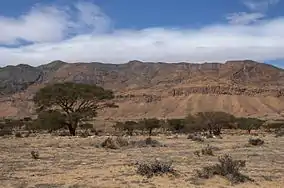| Bou-Hedma National Park | |
|---|---|
 | |
 | |
| Location | Tunisia |
| Nearest city | Gafsa, Sidi Bouzid |
| Coordinates | 34°28′31″N 9°38′57″E / 34.47528°N 9.64917°E |
| Established | 1980 |
| Official name | Sebkhet Noual |
| Designated | 11 July 2007 |
| Reference no. | 1711[1] |
Bou-Hedma National Park is located in both the Gafsa Governorate and Sidi Bouzid Governorate, in Tunisia. The park was created on December 18, 1980, and has been on the UNESCO tentative list of World Heritage Sites since May 28, 2008[2]
The national park is mainly important because of its flora and fauna. Endangered species that have been reintroduced here include scimitar oryx (Oryx dammah), addax (Addax nasomaculatus), ostrich (Struthio camelus camelus) and dama gazelle (Gazella dama mhorr).
Bou-Hedma is an important archaeological site. Starting with the ancient Roman settlements that occupied this place, such as the remains of Roman villages, the Roman bridge of Wadi Bautista, the ancient Roman pools and the rest of the Roman aqueduct.[3]
References
- ↑ "Sebkhet Noual". Ramsar Sites Information Service. Retrieved 25 April 2018.
- ↑ Bou-Hedma National Park in UNESCO
- ↑ "Bou-Hedma National Park, TUNISIA". Med-O-Med. Retrieved 2020-09-21.